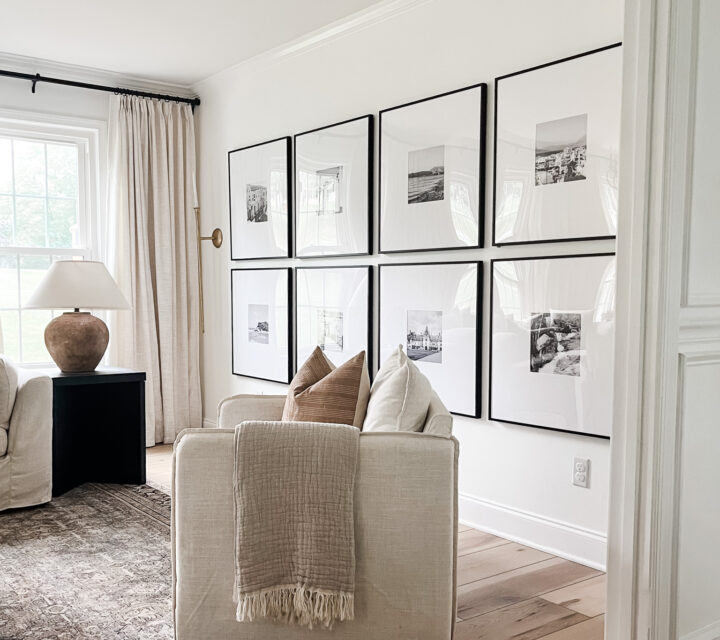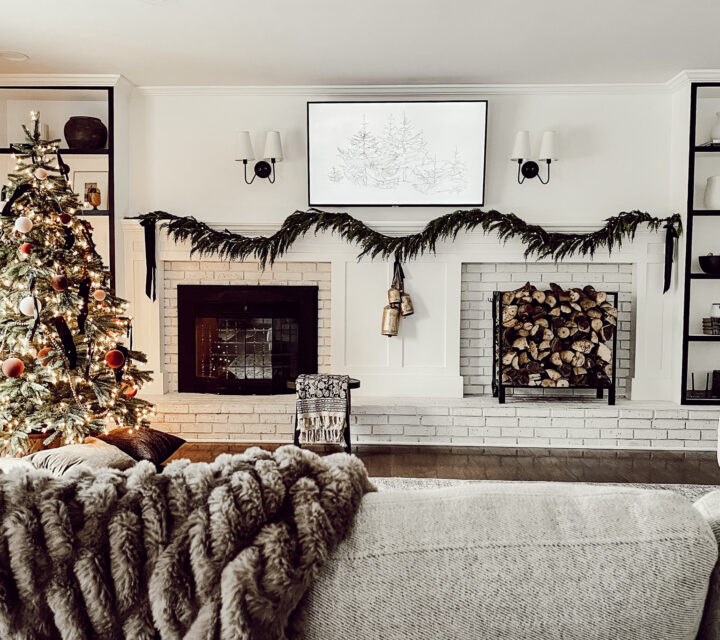In this tutorial, you’ll learn the steps to install DIY Wall moulding.
We just finished installing this DIY wall molding AKA picture frame moulding in our primary bedroom, and it has completely transformed the room.
About a year ago, I shared our picture frame moulding for the nursery. That project was a bit easier than this one because all the picture frame moulding boxes were the same size, and I only tackled one feature wall in the room.

This time around, in our primary bedroom, I decided to add moulding to the entire room! I had a lot more design work to do in advance of installing the moulding because I had to account for every wall and all the furniture placement in the room.
HOW I DETERMINED OUR CUSTOM MOULDING DESIGN
Determining the width of the boxes
There are many ways to design custom picture frame moulding. I chose to design our picture frame moulding around our furniture placement on each wall. Namely, our bed placement and our dresser placement ultimately led the design of our moulding.
Our bed is directly centered under our ceiling fan, but that’s not exactly the center of the room. Instead of designing the moulding around the center of the room, I thought it would look better to design it around where the bed sits on the wall. We added two panels behind the bed of equal diameter.

Then, on either side of the bed I accounted for our nightstands. I designed the two moulding diameters behind the nightstand to be the same on each side. That meant there was some leftover space on the left side of wall, near the window. We added one small picture frame moulding box in the leftover space.

When designing DIY wall moulding, it’s important to design your boxes around the spacing you have instead of trying to make each moulding box the same width. Sometimes, you may end up with equal size moulding boxes, but sometimes it doesn’t make sense to have equal sizes across an entire wall, per the above.
I took the same approach to the wall moulding design on the opposite wall, which is where my long dresser sits. I chose to make one large moulding box so that it surrounds our dresser. Then, on either side of the dresser I added moulding boxes in the leftover space. The boxes on either side of the dresser are close in size but not exactly the same.
Again, I wanted to align the dresser with the bed and ceiling fan so that it felt centered in the space, even though it wasn’t exactly centered.

Determining the height of the boxes
Unlike the moulding box widths, the moulding box heights I kept consistent across the entire room. I came up with a plan to use the windows in my bedroom as my base for box-height sizing. I chose to add two boxes in each row.
For the top moulding boxes, I kept them the same height as the window. For the bottom moulding boxes, I kept them the same height as the space below the window. This sizing allowed everything to look uniform.

Determining the spacing between the moulding
I prefer pretty small spaces between my moulding boxes. I opted for 3” spaces left-to-right, between the moulding boxes and about 1.5” spaces up-and-down, between the moulding boxes.
HOW TO INSTALL DIY WALL MOULDING
Step 1: Determine your moulding design: draw out your plan and figure out measurements
Determining the design should be well thought out. Use my tips from above and consider your moulding box height, width and distance between boxes.
Once you come up with a plan, be sure to draw it out. I drew out what each wall would look like. Then, I started measurements. This will require some math. Write down your measurements on your paper where you drew out your design. I can’t provide you with exact measurements in this tutorial because custom moulding requires that you work with your own specific space and design it to fit your walls.
Here is an example of my plans:

Here is an example of how to determine a box size:
On “wall 1″ in my above drawing, I drew out my windows. Between the windows, I added where a moulding box would go. To determine the size, I measured 3” from each window since that’s the distance I chose to use between boxes. The entire distance between the windows was 42.25”. I subtracted 6” (which would be 3” spaces on each side), which left me with 36.25” for the total moulding length between the window.
Tip – If you want to go the extra mile, you can literally draw out your design on your wall with a pencil. That’s what I did! I wanted to see how it would look before I put the moulding on the wall. My lines are faint in the below image, but if you look hard you can see where I drew on my walls! I used a long level as my tracing tool.

Step 2: Get Moulding from Store
Once you figure out your measurements (per above), you’ll need to determine the total amount of moulding you need. All you need to do is add up all your moulding length measurements.
If you have a car or SUV as opposed to a truck, you’ll need to measure the length of your car so you know how long each moulding piece can be so that it will fit inside.
I have a three row SUV and determined that 10′ boards can fit into my car.

When you’re at the store, you’ll need to cut each moulding piece down to the appropriate size. If you have a truck, you can get the boards as-is and put them in the truck bed.
If you need to cut them, like me, there is a cart in the moulding isle with a measuring tape and hand saw. You’ll need to hand saw each piece of moulding to desired length AKA length of your car, which takes some time and muscle.
There are many types of moulding to choose from. My favorite is the base cap primed pine, 11/16 x 1-3/8 from Home Depot (see below), which is what I used for this project.

Step 3: Cut the Moulding with a Miter Saw
It’s now time to cut each piece of moulding so that it has a 45 degree angle on either side. The specific moulding that I got requires each cut to be angled a certain way. The larger hump of the moulding will be the outer side of each picture frame box, so it needs to be cut accordingly. See below for the positioning of the moulding on the saw.

Each piece needs to be measured and cut per your drawing.
If you’ve never used a miter saw before, it’s not too difficult. This was my first time using it and after I made my first couple cuts, it started to go pretty quick. You just have to toggle between the 45 degree angles on the saw and then cut your pieces.
Watch the below video for a quick how-to on using a miter saw.
I chose to cut a bunch of pieces and then take them as a group to my bedroom and nail them on the wall. I repeated this process about four or five times to finish my walls.
You can go box-by-box and just measure for one box, get it on the wall, and keep repeating this process, but if you do it this way, it may take quite a long time. I got comfortable with cutting and double checked my measurements before cutting, so it eventually started to go pretty quick. Go as slow as you need to, especially if this is your first time using a saw or installing DIY wall moulding.
Step 4: Nail moulding into the wall
For this step, you’ll need a nailer or nail gun, along with a compressor. You’ll also need caulk.

I dabbed a little bit of caulk on the backside of each piece of moulding to give it a little stickiness to the wall. Then, I put the moulding pieces on the wall on my pre-drawn lines, used a level to ensure it was straight and then nailed it in.
For one of the walls, I taped up each piece of moulding before I nailed it in just to ensure I liked it! The tape only held it up for a couple hours so I had to work quickly.


Watch the below video to see my quick run-down of how I nailed the moulding pieces on the wall.
Step 5: Caulk and paint
Once the moulding install was done, we caulked around the sides and filled in the nail holes. After that dried, I painted it using Behr ultra pure white in eggshell.

I absolutely love the result!


TOOLS USED:
(The following contains affiliate links.)
- paper and pencil
- moulding
- measuring tape
- miter saw
- compressor and nail gun
- nails (1-1/4”)
- caulk
- paint – Behr ultra pure white in eggshell



